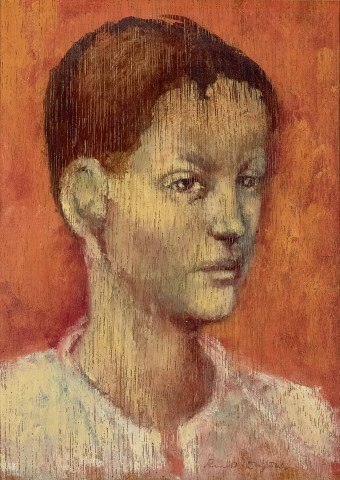HEAD OF A BOY, 1950
RUSSELL DRYSDALE
oil on plywood
20.0 x 14.5 cm
signed lower right: Russell Drysdale
bears inscription with title and date on gallery label verso: EDWARD FORD / 1950 Russell Drysdale / Head of a Boy
Macquarie Galleries, Sydney (label attached verso)
Sir Edward Ford, Sydney
Thence by descent
Private collection
Christie’s, Melbourne, 8 May 2001, lot 6
Private collection, Melbourne
Exhibition of Paintings: English and Australian Artists; Studies for Compositions By Russell Drysdale, Macquarie Galleries, Sydney, 31 May – 12 June 1950, cat. 5
‘Drysdale is the essential Australian painter. Many gifted painters have come out of Australia, and one of them, Sidney Nolan, is a universal figure. But no one except Drysdale gives the same authentic feeling of the resolute humanity that has managed to exist in that terrible continent. Those who love Australia and the Australians as I do will find their feelings reflected in the bold, sincere and deeply human records he has made of the landscape and its inhabitants, black and white. To anyone who cannot visit Australia, I would say look at the paintings of Drysdale and you will understand why so many unexpected people admire Australia.’1
During the mid to late 1940s, Drysdale embarked upon a small group of portraits of children in the outback that reveal an acute awareness and empathy for the vulnerability and stoicism of childhood. Combining a sense of both the fragility and toughness of adolescence, Head of a Boy, 1950 is one such image which, with the sitter’s classical, ovaloid face and unwavering gaze, illustrates well the enduring influence of Modigliani upon Drysdale’s art. As is characteristic of many of Drysdale’s portraits, an overwhelming humanity and empathy pervades the work, transcending the individual to contemplate rather the universal human condition. As Professor Bernard Smith poignantly observed of Drysdale’s iconic Two Children, 1945 – 46 (National Gallery of Victoria, Melbourne) – another portrait of children from this period which features among the artist’s most widely admired images – ‘…By virtue of its formal perfection and profound but controlled feeling, the small painting reaches beyond the individual and the regional to express the consuming loneliness of humankind.’2
1. Clark, K., ‘A Tribute to Russell Drysdale’, in Klepac, L., The Life and Work of Russell Drysdale, Bay Books, Sydney, 1980, p.9
2. Smith, B., & Smith, T., Australian Painting 1789 – 1990, Oxford University Press, Melbourne, 1991, p. 249
VERONICA ANGELATOS
